One of Washington's favorite hikes, Rattlesnake Ledge, gets a major makeover
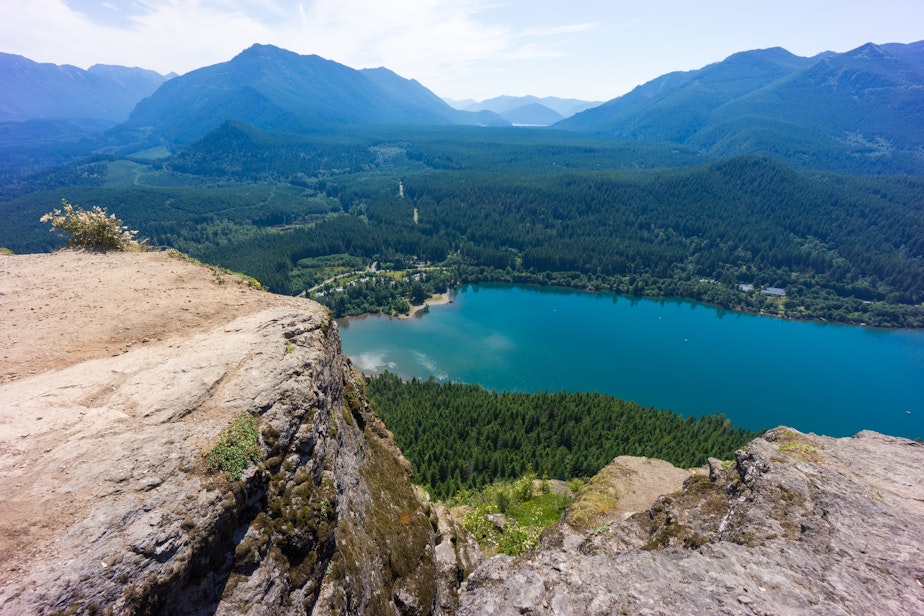
The trail to Rattlesnake Ledge is one of Washington's most popular hikes, and leads to one of the most recognizable views in the Seattle region. This summer, the trail will look a little different thanks to a major overhaul prompted by an increase in visitors.
Even at 8 a.m. on a rainy Tuesday morning, Rattlesnake Ledge is a popular destination. More than a dozen cars sit in the gravel parking lot at the trailhead, four miles south of North Bend. Trail runners and groups of college-age hikers emerge and head into the forest.
Eight Washington Trails Association volunteers gather in a loose circle nearby, pulling on muddy rain gear and colorful hard hats. Emily Snyder's blue hat marks her as the crew lead for the day.
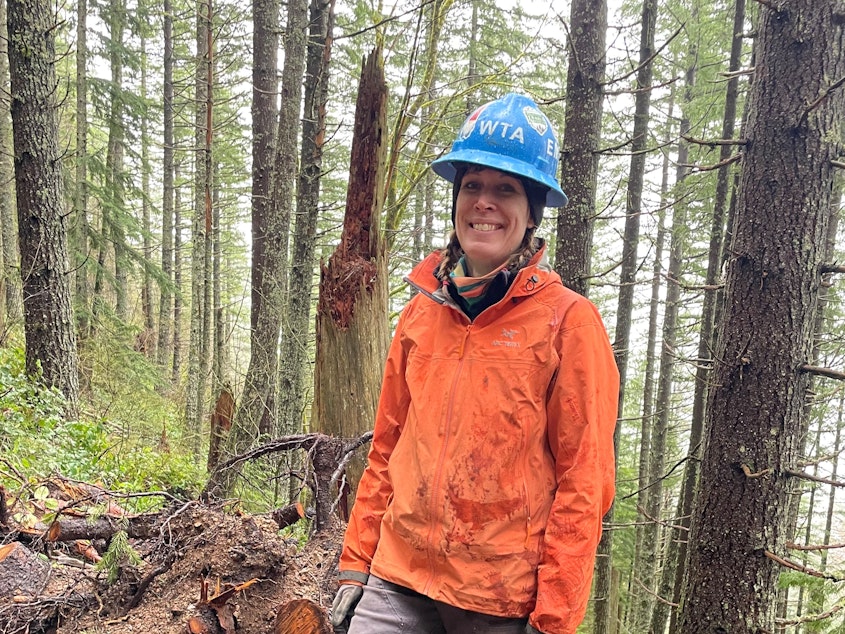
"We are finishing up a long winter's worth of work up here," she tells the group. "Sounds like we are working almost all the way at the top."
The crew's current task is to wrap up a renovation of the trail that began in 2020.
Sponsored
Hiking boom vs Rattlesnake Ledge
The Rattlesnake Ledge trail was built nearly 20 years ago through a collaboration between WTA, the Mountains to Sound Greenway Trust, and Seattle Public Utilities, which owns the land around Rattlesnake Lake.
Planners initially thought the hike would see 70,000 visitors a year. But the Seattle area exploded over the next 15 years and Rattlesnake Ledge's popularity grew along with it.
The hike's stunning views, relatively low difficulty and proximity to Seattle made it a favorite among first-time hikers and families.
Sponsored
These days, it gets 300,000 visitors a year, more than quadruple the original estimate, and all those extra feet were damaging the trail.
"First and foremost, there's just more people walking up and down it," said Kindra Ramos, communications and outreach director for WTA.
More people also means more traffic jams, causing hikers to step off the trail to let others pass.
"There's more opportunities with those interactions to unintentionally either erode the side of the trail as you're trying to make space, or step on some of the local flora," Ramos said.
The trail renovation is aimed at creating more space for hikers, but also at designing the trail more sustainably so that it can stand up to wear and tear.
Sponsored
"It's often people's first hike. It's where you take friends visiting. It's where you take your family," Ramos said. The trail renovation is about ensuring "that experience can continue to be around for the next generation of hikers."
The initial layout of the renovated trail was done by a contractor, but much of the work to make it functional — and, frankly, pretty — falls to WTA volunteer crews.
Building a beautiful trail
Emily Snyder's crew of eight is among the last to work on Rattlesnake Ledge's renovation. Their job is to finish a few projects at the very end of the hike.
On the way up, Snyder chats with Patricia Murphy, host of KUOW podcast Seattle Now. She pauses at one point about half way up.
Sponsored
"This is a really good place to be able to see where the old trail is narrow and rooty and crumbling away from the hillside," Snyder said, gesturing to a path blocked by logs that winds its way almost straight up the slope.
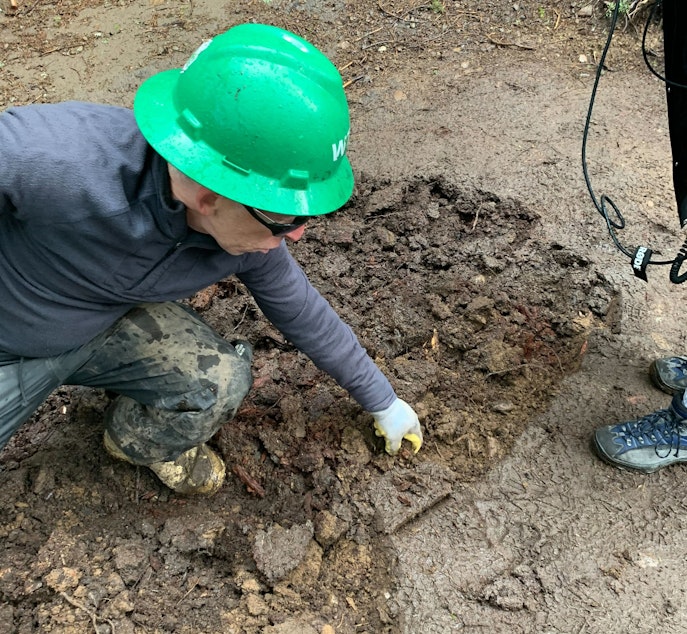
"The new trail ... is a nice, lovely, wide, flat trail — very sustainable, with good drains put in — that goes up to the corner of the contour. And then it's going to cut around the hillside and climb back up instead of going up and over the top of it."
The new trail has a gentler grade, which makes it more accessible for less seasoned hikers. It also makes it stand up better to erosion from all the boots that tromp over it day in and day out.
WTA maintenance trail volunteers do a wide variety of work, from removing trees that fall onto trails to building bridges and retaining walls. Volunteers put about 170,000 hours of work into trails on an average year.
Sponsored
Some of the most important work is also the most subtle, like replanting ferns in the trail corridor or scraping off certain kinds of soil and replacing it with more durable material.
The width of the Rattlesnake Ledge trail is one of the crew's biggest priorities. Most hiking paths are three feet wide, but to allow for a passing lane, Rattlesnake Ledge is an even five feet the whole way up.
Of course, there aren't any yard sticks in the forest, so the crew has to get creative with how it measures.
"We stand in the middle ... and stick our arms out sideways, and that should be the width of the trail," Snyder said. "Or we use the tools. The handle on the shovel is as wide as the trail needs to be."
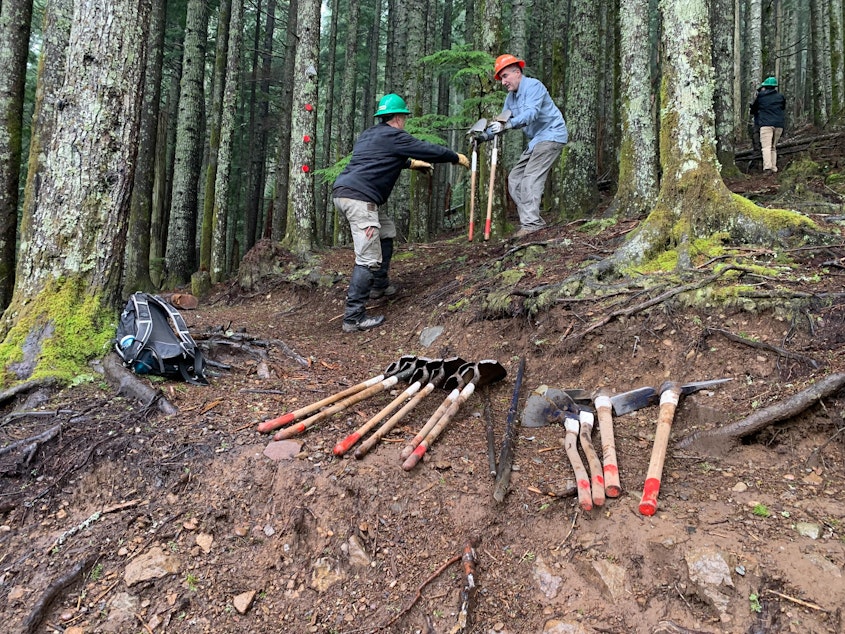
Snyder also looks out for places where people diverge from the trail or take shortcuts. Switchbacks, when the path doubles back on itself, are a common culprit.
She points out one switchback where the hillside was crumbling away.
"The back slope wasn't real stable. It's just loose soil," she said. "People were cutting the corner, crawling up the hillside and making this crumble even more, just making the trail really narrow above it."
The crew reinforced the slope between the two parts of the trail with a rock wall and lined the top with logs to make it harder to cut the corner.
"We want the hillside to be sustainably held in there, so that's the physical barrier. But we also don't want to make it look climbable or fun and inviting ... And we want it to all look natural."
Snyder says hiker psychology is a big part of how they design a trail, from strategically placed rocks to the material they choose for the surface.
Barry Roitblat is on soil duty. Once the volunteers reach their work site, he grabs a hoe and starts tearing up a wet, muddy section of the trail.
Wet stretches of trails are often caused by duff, the rich soil that comes from organic material breaking down. It's great for your garden, but not a good walking surface.
"Here you can see where it broke through, the lighter color," Roitblat says, pointing to a smear of beige under the dark brown of the surface.

"That's the mineral soil we're trying to get to," he explains. "It'll pack down and won't puddle as much."
Puddles forming on a trail can erode it, but the bigger issue is how hikers react, Ramos said.
"From a hiker mentality, it's not our natural inclination to want to walk through the puddle. And so again, people are stepping around, and that can be one of the causes of widening trails."
Further down the trail, two volunteers lay stones in a drainage channel to even it out.
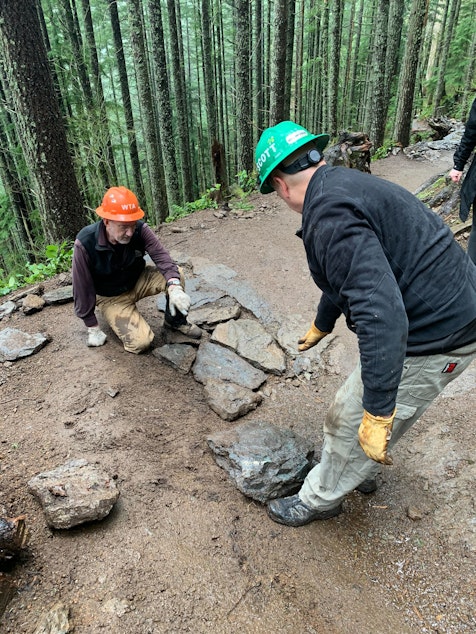
Snyder explains that they're mellowing the slope of the trail so people will walk straight up the middle instead of hugging one side.
"We call it changing the elevation, and we frequently achieve that by moving dirt down from above," Snyder said.
Adding a layer of rocks means moving less dirt and also water drain through the channel better.
As the volunteers work, hikers pass by every few minutes. One girl in a puffy pink jacket gets compliments from the crew.
Most of the hikers thank the volunteers on their way through.
"Keep up the good work," one man shouts as he jogs up the hillside. "What a trail!
This story was produced by KUOW's Seattle Now podcast, a daily show about what's going on in and around the city. Subscribe to the show in your favorite podcast app or listen on KUOW.org.





